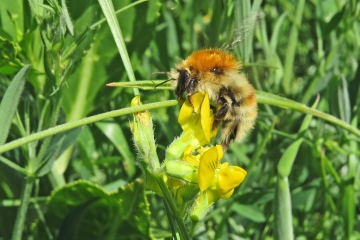Species Account for Bombus muscorum
Bombus muscorum (Linnaeus, 1758)
a bumblebee
Aculeata: Apinae: Apinae

Reproduction for study and non-profit use permitted, all other rights reserved.
Taxonomic group: honey bee and bumblebees (Aculeata: Apinae) - Countywide data
View time series maps for Bombus muscorum
member log-on for taxon report
Status: EN (European);Section 41 Priority Species
Essex RDB: Listed
Threat: Essex Vulnerable
Images
upload a new image
Essex Red Data List comment
Already lost from at least one post-1980 breeding site. Declining.
Species text
Bumblebees operate at a landscape scale. Distinguishing this species in the field from B. humilis and some forms B. pascuorum is very difficult, if not impossible. Like B. humilis, this is an increasingly scarce, Biodiversity Action Plan species, with a scattered but mainly coastal distribution in Britain. In Essex all modern records have been coastal extending as far south as Foulness but not into the East Thames Corridor, where its place is taken by B. humilis. In north-east Essex Ted Benton has found the species to be very thinly but widely distributed, and it seems that the bumblebee is currently rapidly declining (Benton 2000). The discovery of the bumblebee inland at Sergeants Orchard in 2004 suggests that there may be a viable metapopulation in the interesting area of Essex south of Sudbury and around Bures and Wormingford. Bumblebee populations appear to operate at a landscape scale and it is probable that viable individual populations require minimum ranges of between ten to twenty sq. km of good matrix habitat within farmland (Edwards 1998), and it is the dramatic decline in the quality of wildlife habitat in the modern agricultural countryside that is almost certainly the main reason for the massive declines seen in these and other bumblebee species. Only six species Bombus hortorum, B. lucorum, B. lapidarius, B. pascuorum, B. pratorum and B. terrestris and some of their cuckoo parasites remain widespread and frequent, perhaps faring better than the scarce species because they are less dependent on flowers with long corolla tubes and are better able to successfully forage in gardens. Like other carder bees B. muscorum is probably reliant on a relatively restricted range of flowers, mainly in the Fabiaceae, Lamiaceae and Scrophulariaceae, such as Red Clover Trifolium pratense, White Deadnettle Lamium album, Black Horehound Ballota nigra and Red Bartsia Odontites verna but also including certain Asteraceae such as Spear Thistle and Hardhead Centaurea nigra. These are all plants that used to be commonly found in the countryside, but are now rarely found in the quantities required to support dependent foraging insects. Like other carder bees, B. muscorum builds its nest on or near the surface of the ground, using dead grasses or moss from the litter layer as materials. Various sites are used, most often among long grass, but often with the top of the nest exposed to the sun. References
Habitats
Recorded management for locations with Bombus muscorum
Recorded substrate and hydrology for locations with Bombus muscorum
Why not join the Club, register and add a new species page
Interpretation of distribution maps



















